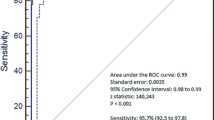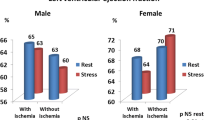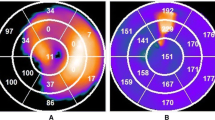Abstract
Objectives
The purpose of this study is to develop a right-ventricular (RV) phase analysis tool which when coupled with our left ventricular (LV) phase analysis tool can provide measurement of the interventricular mechanical dyssynchrony from gated SPECT myocardial perfusion imaging (MPI), and validate the tool by electrocardiography (ECG).
Methods
For each patient, short-axis LV and RV SPECT MPI images were input into an automatic sampling algorithm to generate the 3D maximal count circumferential profiles for both LV and RV in each cardiac frame. Subsequently, the samples of LV and RV were separately used by our phase analysis tool based on the first-harmonic Fourier approximation to calculate the contraction onset for each sample. The difference between contraction onsets of the middle LV free wall and middle LV septal wall represented the LV contraction delay; the difference between contraction onsets of the middle RV free wall and middle RV septal wall represented the RV contraction delay. The difference between the LV and RV contraction delays represented the interventricular contraction delay, which was compared with the interventricular conduction delay classified by ECG to validate the concordance of interventricular mechanical and electrical dyssynchrony. Sixty-one bundle branch block (BBB) patients with ischemic-dilated cardiomyopathy (26, 42.6%) or non-ischemic-dilated cardiomyopathy (35, 57.4%), who underwent 12-lead surface ECG and gated resting Tc-99m sestamibi SPECT, were retrospectively analyzed in this study.
Results
In the 30 patients with left bundle branch block (LBBB) by ECG, there were 27 patients whose LV contracted later than the RV according to SPECT; and in the 31 patients with right bundle branch block (RBBB) by ECG, there were 26 patients whose LV contracted earlier than the RV according to SPECT. In total, an agreement rate of 86.9% (53 of 61) was achieved between SPECT and ECG. The Kappa agreement rate was 73.8% (95% confidence interval 0.57-0.91).
Conclusion
The preliminary results showed promise for the measurement of interventricular mechanical dyssynchrony in BBB patients with dilated cardiomyopathy using our phase analysis tool.



Similar content being viewed by others
Abbreviations
- RV:
-
Right ventricle/ventricular
- LV:
-
Left ventricle/ventricular
- SPECT:
-
Single-photon emission computed tomography
- MPI:
-
Myocardial perfusion imaging/images
- ECG:
-
Electrocardiography
- CRT:
-
Cardiac resynchronization therapy
- LBBB:
-
Left bundle branch block
- RBBB:
-
Right bundle branch block
- OSEM:
-
Ordered subset expectation maximization
References
Richardson M, Freemantle N, Calvert MJ, Cleland JG, Tavazzi L. Predictors and treatment response with cardiac resynchronization therapy in patients with heart failure characterized by dyssynchrony: A pre-defined analysis from the CARE-HF trial. Eur Heart J 2007;28:1827-34.
Wiesbauer F, Baytaroglu C, Azar D, Blessberger H, Goliasch G, Graf S, et al. Echo Doppler parameters predict response to cardiac resynchronization therapy. Eur J Clin Invest 2009;39:1-10.
Galderisi M, Cattaneo F, Mondillo S. Doppler echocardiography and myocardial dyssynchrony: A practical update of old and new ultrasound technologies. Cardiovasc Ultrasound 2007;5:28.
Chung ES, Leon AR, Tavazzi L, Sun JP, Nihoyannopoulos P, Merlino J, et al. Results of the predictors of response to CRT (PROSEPCT) trial. Circulation 2008;117(20):2608-16.
Chen J, Garcia EV, Folks RD, Cooke CD, Faber TL, Tauxe EL, et al. Onset of left ventricular mechanical contraction as determined by phase analysis of ECG-gated myocardial perfusion SPECT imaging: Development of a diagnostic tool for assessment of cardiac mechanical dyssynchrony. J Nucl Cardiol 2005;12:687-95.
Boogers MJ, Chen J, van Bommel RJ, Borleffs CJ, Dibbets-Schneider P, van der Heil B, et al. Optimal left ventricular lead position assessed with phase analysis on gated myocardial perfusion SPECT. Eur J Nucl Med Mol Imaging 2011;38:230-8.
Friehling M, Chen J, Saba S, Bazaz R, Schwartzman D, Adelstein EC, et al. A prospective pilot study to evaluate the relationship between acute change in left ventricular synchrony after cardiac resynchronization therapy and patient outcome using a single-injection gated SPECT protocol. Circ Cardiovasc Imaging 2011;4:532-9.
Henneman MM, Chen J, Ypenburg C, Dibbets P, Bleeker GB, Boersma E, et al. Phase analysis of gated myocardial perfusion SPECT compared to tissue Doppler imaging for the assessment of left ventricular dyssynchrony. J Am Coll Cardiol 2007;49:1708-14.
Marsan NA, Henneman MM, Chen J, Ypenburg C, Dibbets P, Ghio S, et al. Left ventricular dyssynchrony assessed by two 3-dimensional imaging modalities: Phase analysis of gated myocardial perfusion SPECT and tri-plane tissue Doppler imaging. Eur J Nucl Med Mol Imaging 2008;35:166-73.
DePuey EG, Jones ME, Garcia EV. Evaluation of right ventricular regional perfusion with technetium-99m-sestamibi SPECT. J Nucl Med 1991;32(6):1199-205.
Becker M, Hoffmann R, Schmitz F, Hundemer A, Juhl H, Schauerte P, et al. Relation of optimal lead positioning as defined by three-dimensional echocardiography to long-term benefit of cardiac resynchronization. Am J Cardiol 2007;100(11):1671-6.
Chau J, Zhou W, Ho JK, Patel NA, Mackensen GB, Mahajan A. Acute right ventricular pressure overload compromises left ventricular function by altering septal strain and rotation. J Appl Physiol 2013;115(2):186-93.
ACCF/AHA/HRS. ACCF/AHA/HRS focused update incorporated into the ACCF/AHA/HRS 2008 guidelines for device-based therapy of cardiac rhythm abnormalities: A report of the American College of Cardiology Foundation/American Heart Association Task Force on Practice Guidelines and the Heart Rhythm Society. Circulation 2008;2013(127):e283-352.
Tompkins C, Kutyifa V, McNitt S, Polonsky B, Klein HU, Moss AJ, et al. Effect on cardiac function of cardiac resynchronization therapy in patients with right bundle branch block (from the Multicenter Automatic Defibrillator Implantation Trial With Cardiac Resynchronization Therapy [MADIT-CRT] trial). Am J Cardiol 2013;112:525-9.
Haghjoo M, Bagherzadeh A, Fazelifar AF. Prevalence of mechanical dyssynchrony in heart failure patients with different QRS durations. Pacing Clin Electrophysiol 2007;30:616-22.
Hawkins NM, Petrie MC, MacDonald MR, Hogg KJ, McMurray JJ. Selecting patients for cardiac resynchronization therapy: Electrical or mechanical dyssynchrony? Eur Heart J 2006;27:1270-81.
Delgado V, Bax JJ. Assessment of systolic dyssynchrony for cardiac resynchronization therapy is clinically useful. Circulation 2011;123:640-55.
Jia P, Ramanathan C, Ghanem RN, Ryu K, Varma N, Rudy Y. Electrocardiographic imaging of cardiac resynchronization therapy in heart failure: Observation of variable electrophysiologic responses. Heart Rhythm 2006;3:296-310.
Vatasescu R, Berruezo A, Mont L, Tamborero D, Sitges M, Silva E, et al. Midterm, “super-response” to cardiac resynchronization therapy by biventricular pacing with fusion: Insights from electro-anatomical mapping. Europace 2009;11:1675-82.
Cleland JG, Daubert JC, Erdmann E. The effect of cardiac resynchronization on morbidity and mortality in heart failure. N Engl J Med 2005;352:1539-49.
Chen J, Faber TL, Cooke CD, Garcia EV. Temporal resolution of multi-harmonic phase analysis of ECG-gated myocardial perfusion SPECT studies. J Nucl Cardiol 2008;15:383-91.
Trimble MA, Velazquez EJ, Adams GL, Honeycutt EF, Pagnanelli RA, Barnhart HX, et al. Repeatability and reproducibility of phase analysis of gated SPECT myocardial perfusion imaging used to quantify cardiac dyssynchrony. Nucl Med Commun 2008;29:374-81.
AlJaroudi W, Iqbal F, Heo J, Iskandrian AE. Relation between heart rate and left ventricular mechanical dyssynchrony in patients with end-stage renal disease. Am J Cardiol 2011;107:1235-40.
Cheung A, Zhou Y, Faber TL, Garcia EV, Zhu L, Chen J. The performance of phase analysis of gated SPECT myocardial perfusion imaging in the presence of perfusion defects: A simulation study. J Nucl Cardiol 2012;19:500-6.
Wang L, Zhou W, Liang Y, Yang Y, Garcia EV, Chen J, et al. Right ventricular dyssynchrony in pulmonary hypertension: Phase analysis using FDG-PET imaging. J Nucl Cardiol 2015. doi:10.1007/s12350-015-0341-y.
Berman DS, Germano G, Slomka PJ. Improvement in PET myocardial perfusion image quality and quantification with flurpiridaz F 18. J Nucl Cardiol 2012;19:S38-45.
Acknowledgments
This research was partly supported by a grant from the American Heart Association (15POST22690035, PI: Weihua Zhou, Ph.D.) and a New Faculty startup grant from the University of Southern Mississippi (Project No.: DE01791). Drs. Chen and Garcia receive royalties from the sales of Emory Cardiac Toolbox.
Disclosure
The terms of this arrangement have been reviewed and approved by Emory University in accordance with its conflict-of-interest practice.
Author information
Authors and Affiliations
Corresponding author
Additional information
See related editorial, doi:10.1007/s12350-016-0550-z
Rights and permissions
About this article
Cite this article
Zhou, W., Jiang, Z., Chen, J. et al. Development and validation of a phase analysis tool to measure interventricular mechanical dyssynchrony from gated SPECT MPI. J. Nucl. Cardiol. 24, 1680–1686 (2017). https://doi.org/10.1007/s12350-016-0503-6
Received:
Accepted:
Published:
Issue Date:
DOI: https://doi.org/10.1007/s12350-016-0503-6




